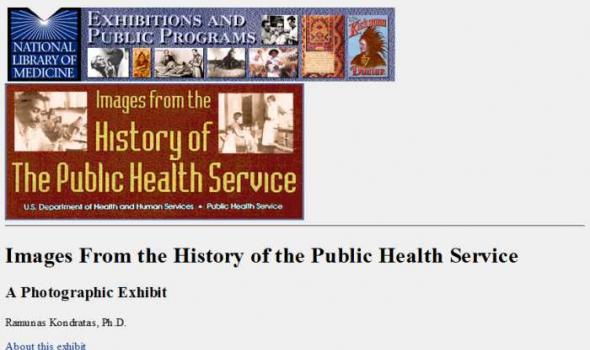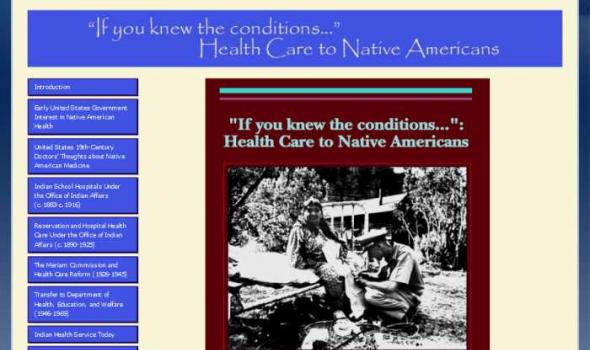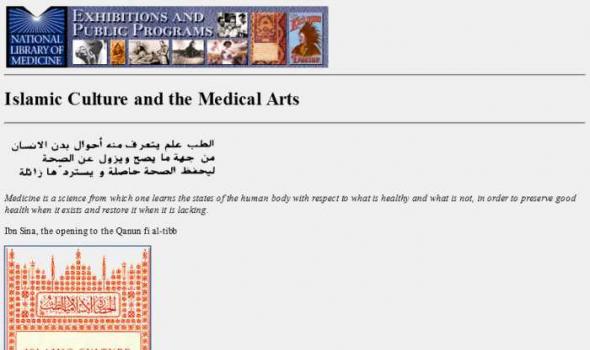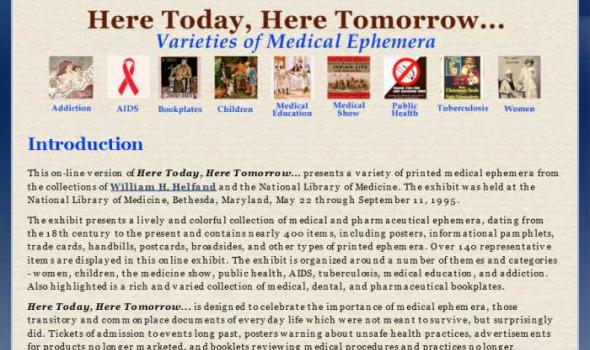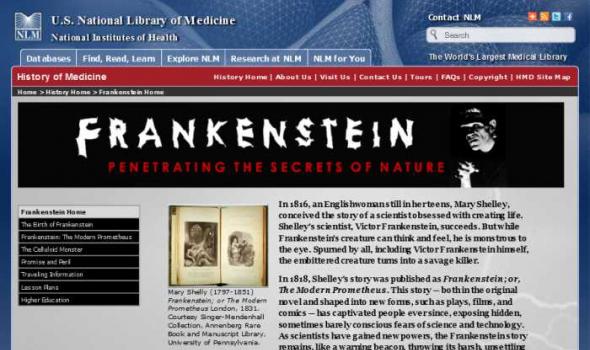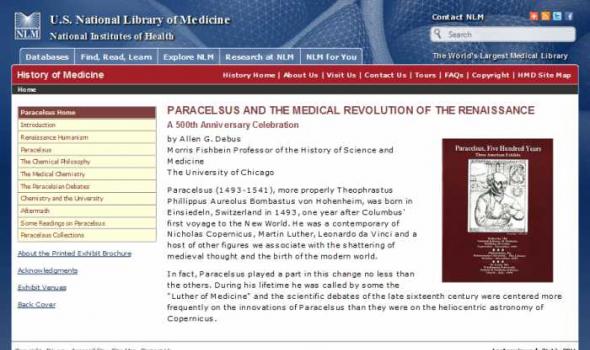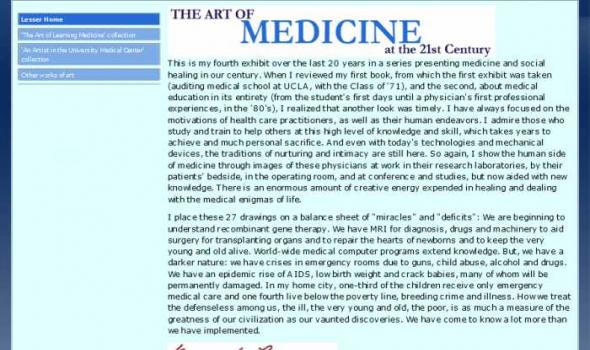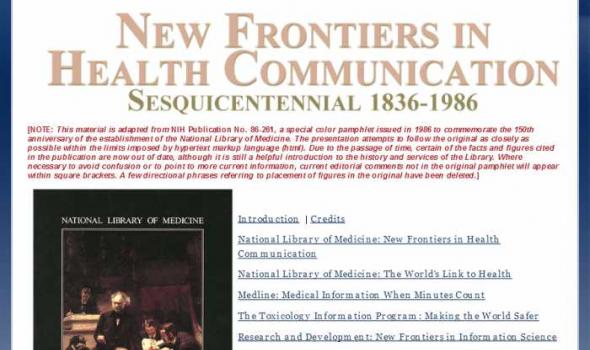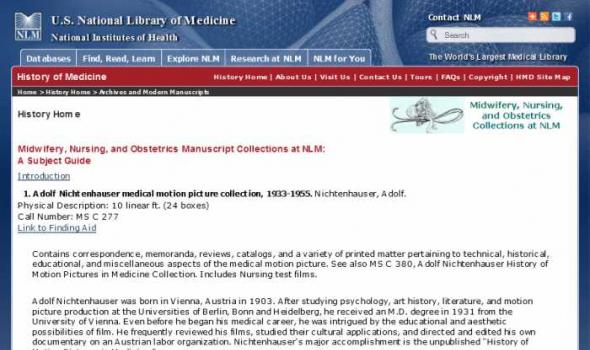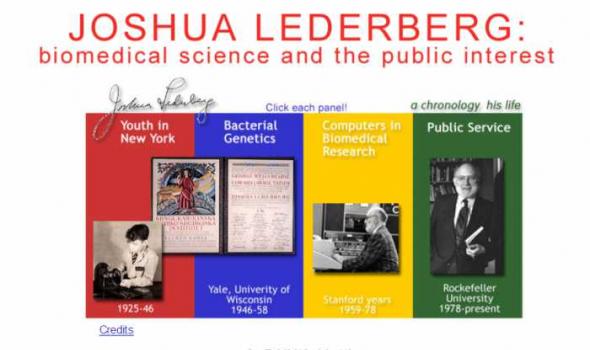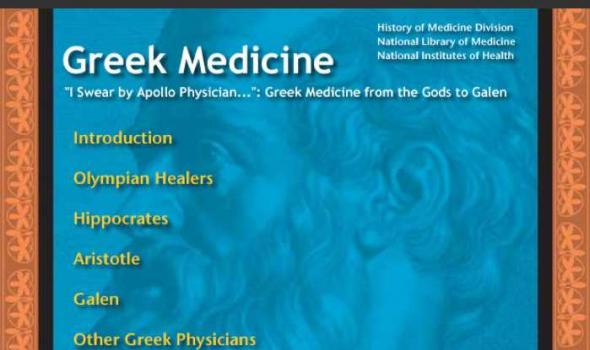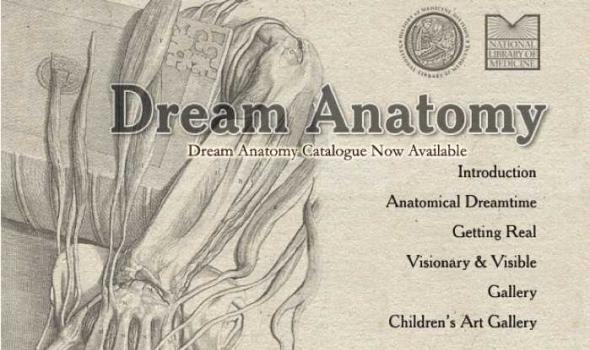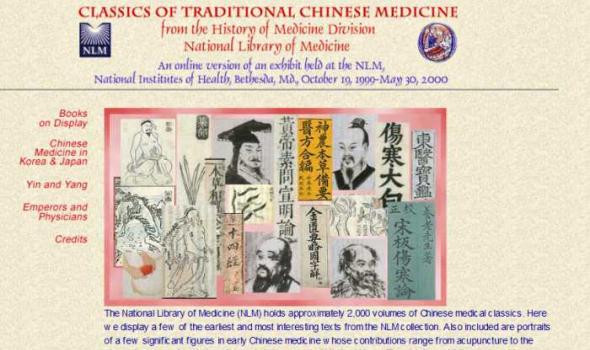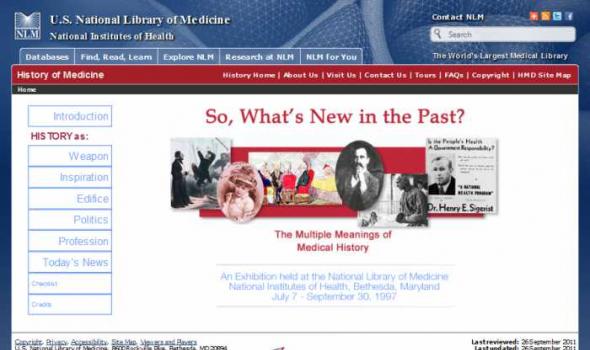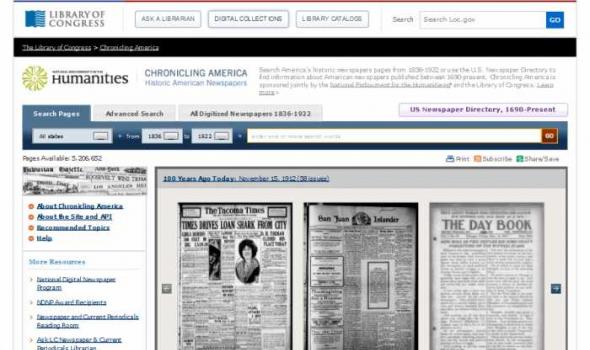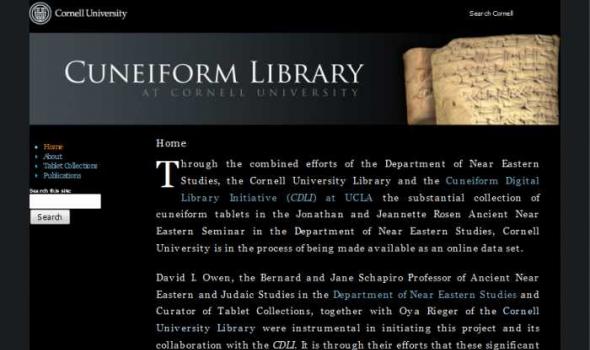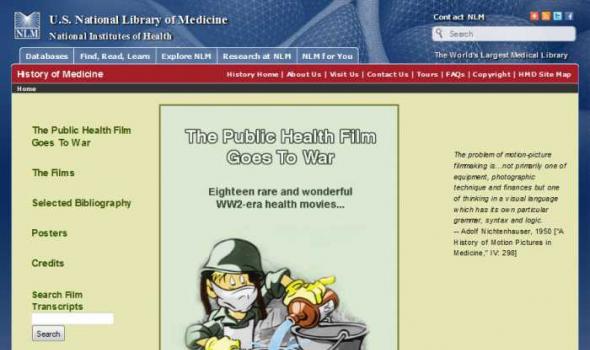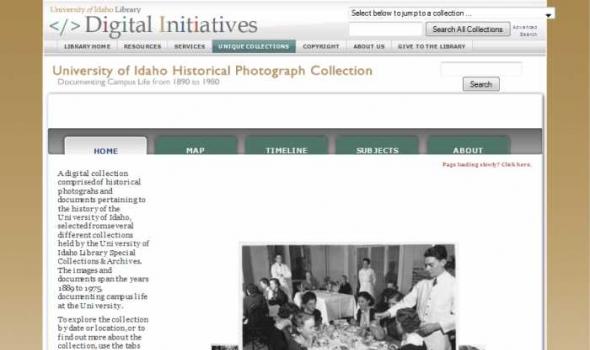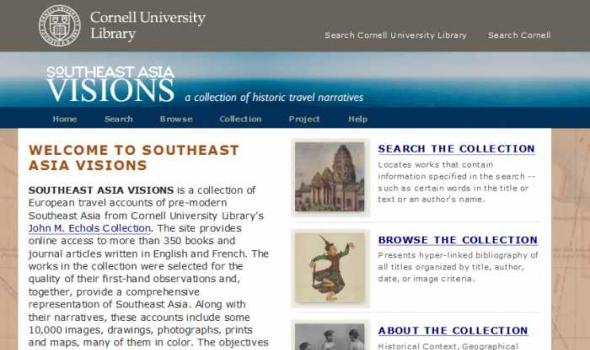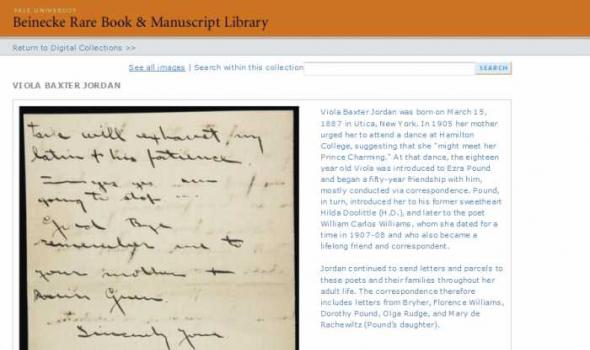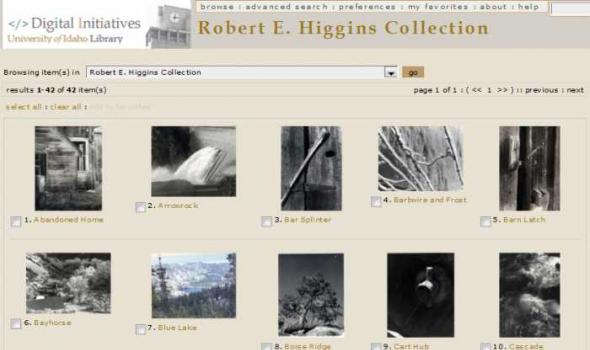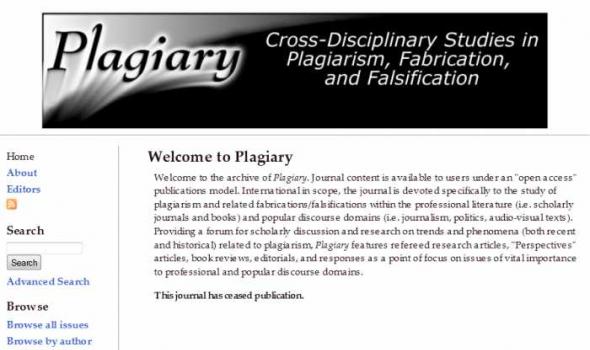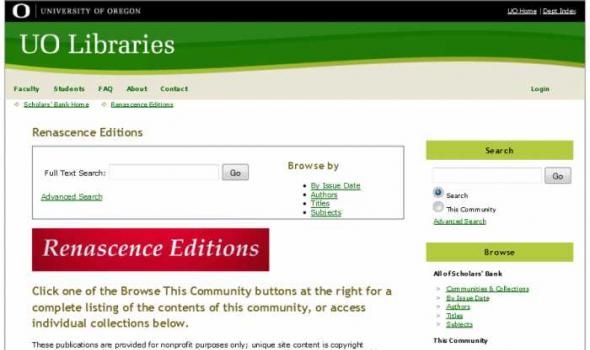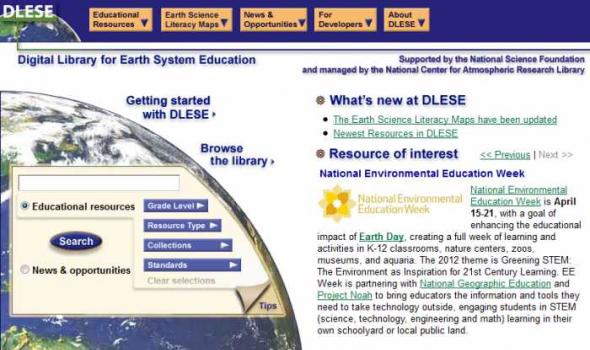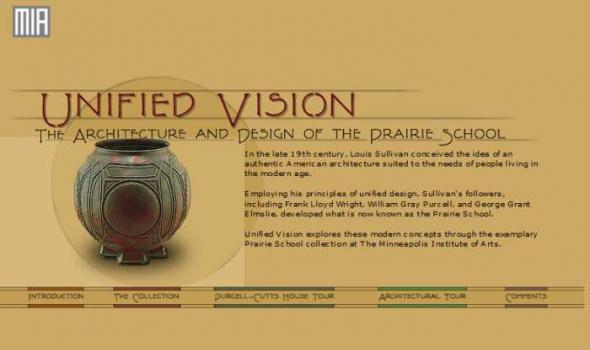Category: U.S. National Library of Medicine
Results
Images From the History of the Public Health Service A Photographic Exhibit Table of Contents Disease Control and Prevention About this exhibit The original work is dedicated to the memory of Ronald J. Kostraba (1942-1991) of the OASH Administrative Services Center, whose dedication to design excellence, tireless research and planning produced this exhibit. The online version was prepared by David Harding under the supervision of R. P. C. Rodgers, M.D. It is organized according to the pagination of the original printed document. Minor factual and spelling corrections have been made to the original text.
History of Medicine Early United States Government Interest in Native American Health Although U.S. Army surgeons treated Native American victims of smallpox near the opening of the 19th-century, government concern for Native American health at this time was manifest more in counting the numbers of people who died from this and other diseases, and estimating how many were left, than in providing institutional remedies. Jedidiah Morse's report indicates this interest: Determining where "Indians" were in North America and how many they were. The report is addressed to the Secretary of War. Indian affairs were administered by the War Department until 1849. The U.S.
Islamic Culture and the Medical Arts Preface On the 30th of November 1094 AD (or to be more precise, the 19th of the month Dhu al-Qa`dah in the year 487 of the Muslim era), a scribe in Baghdad completed a copy of an Arabic treatise by one of the most important medieval physicians and clinicians -- Abu Bakr Muhammad ibn Zakariya' al-Razi, who worked in Baghdad in the previous century and was later known to Europe as Rhazes. This manuscript is the oldest volume in the National Library of Medicine (NLM) and the third oldest Arabic manuscript on any medical topic known to be preserved today.
This on-line version of Here Today, Here Tomorrow... presents a variety of printed medical ephemera from the collections of William H. Helfand and the National Library of Medicine. The exhibit was held at the National Library of Medicine, Bethesda, Maryland, May 22 through September 11, 1995.
History of Medicine In 1816, an Englishwoman still in her teens, Mary Shelley, conceived the story of a scientist obsessed with creating life. Shelley's scientist, Victor Frankenstein, succeeds. But while Frankenstein's creature can think and feel, he is monstrous to the eye. Spurned by all, including Victor Frankenstein himself, the embittered creature turns into a savage killer. In 1818, Shelley's story was published as Frankenstein; or, The Modern Prometheus . This story — both in the original novel and shaped into new forms, such as plays, films, and comics — has captivated people ever since, exposing hidden, sometimes barely conscious fears of science and technology.
History of Medicine Introduction This exhibit [and accompanying brochure] highlight the joint observance of the 500th anniversary of the birth of Paracelsus by three American medical libraries -- The Hahnemann University Library, The National Library of Medicine, and The Washington University Medical Library (St. Louis). It has been prepared to accompany the special exhibits which, along with lectures and other programs, are being organized at these libraries. The intent of the various events is to celebrate as well as to explain the contributions of this major Renaissance figure, especially those in medicine, chemistry, and pharmacy.
History of Medicine Cesarean Section - A Brief History Preface Cesarean section has been part of human culture since ancient times and there are tales in both Western and non-Western cultures of this procedure resulting in live mothers and offspring. According to Greek mythology Apollo removed Asclepius, founder of the famous cult of religious medicine, from his mother's abdomen. Numerous references to cesarean section appear in ancient Hindu, Egyptian, Grecian, Roman, and other European folklore. Ancient Chinese etchings depict the procedure on apparently living women. The Mischnagoth and Talmud prohibited primogeniture when twins were born by cesarean section and waived the purification rituals for women delivered by surgery.
History of Medicine Home > History Home > Lesser Home This is my fourth exhibit over the last 20 years in a series presenting medicine and social healing in our century. When I reviewed my first book, from which the first exhibit was taken (auditing medical school at UCLA, with the Class of '71), and the second, about medical education in its entirety (from the student's first days until a physician's first professional experiences, in the '80's), I realized that another look was timely. I have always focused on the motivations of health care practitioners, as well as their human endeavors. I admire those who study and train to help others at this high level of knowledge and skill, which takes years to achieve and much personal sacrifice.
History of Medicine Instruction in Surgery. Five physicians and their colleagues in the surgical amphitheatre of the Massachusetts General Hospital watch as the anesthetist administers ether to a patient who is about to have surgery. This illustration appeared in an 1889 issue of Harper's Weekly . The National Library of Medicine was originally established 150 years ago, in 1836, as the Library of the Army Surgeon General's Office. Perhaps the key event in the library's history occurred in 1865, when Dr. John Shaw Billings became director. For the next 30 years he worked tirelessly to expand the library's holdings and open it as a source of biomedical information for all physicians.
History of Medicine INTRODUCTION Tropical medicine began in the nineteenth century when doctors diagnosed infectious diseases in soldiers and colonists who had lived in tropical areas. In 1877, English scientist Sir Patrick Manson proved that mosquitoes spread elephantiasis to humans and he later theorized that the same was true with malaria. This was an enormous step in tropical medicine and the understanding of tropical diseases, leading to advances in prevention methods. The field of tropical medicine consists of the study, treatment, and prevention of tropical diseases. Tropical diseases can be defined as those that are mainly of parasitic origin and are common in tropical or subtropical areas.
History of Medicine Introduction This guide describes the modern manuscript collections concerning Nursing, Midwifery and Obstetrics found in the History of Medicine Division. These collections include lecture notes on midwifery, records of nursing schools and associations, and the correspondence and personal papers of persons involved in the fields of Nursing and Midwifery. Persons mentioned include Francis Henry Ramsbotham and James Young Simpson. A majority of the collections are dated from the nineteenth and twentieth centuries, although there are several collections from the eighteenth century. Subjects are listed alphabetically with an index of terms. Brief descriptions include author of collection, physical description, and call number.
History of Medicine Introduction This Guide to Collections relating to the History of Artificial Organs is a review of materials located in known repositories as well as private and corporate holdings worldwide. This guide is an introduction, not an inventory, to the papers, records, films, tapes, interviews and artifacts relevant to the history of artificial organ developments. Purpose of the Guide This Guide is intended to serve many purposes. It marks an essential first step towards preserving the documentary history of artificial organ developments in the United States and abroad. It is intended to bring attention to the need to preserve recent medical science history before documents and devices are lost.
History of Medicine Bacterial Genetics: 1946-58 His inquisitiveness, facility for establishing connections between scientific disciplines, and grasp of institutional strategy led Joshua Lederberg to the forefront of successive advances in science: molecular genetics in the 1940s and 1950s; the search for extraterrestrial life in the 1950s and 1960s; computers and artificial intelligence in the 1960s and 1970s. His discoveries in genetics produced a deeper understanding not only of the biochemical mechanism of inheritance and mutation in microorganisms, but of the evolution of diseases, the causes of drug resistance, and the possibilities of genetic engineering and gene therapy.
Last updated: 14 January 2009 The Loss and Recovery of Greek Medicine in the West After the fall of the Roman Empire in the 5th century, most works of the Greek physicians were lost to Western Europe. In the 14th and 15th centuries, however, Western Europeans began to rediscover Greek scientific and medical texts. This was due in part to the discovery of Arab repositories of learning in Spain and elsewhere during the Crusades as well as the immigration to Italy of Byzantine scholars at the fall of Constantinople in 1453.
Introduction: Dream Anatomy The interior of our bodies is hidden to us. What happens beneath the skin is mysterious, fearful, amazing. In antiquity, the body's internal structure was the subject of speculation, fantasy, and some study, but there were few efforts to represent it in pictures. The invention of the printing press in the 15th century-and the cascade of print technologies that followed-helped to inspire a new spectacular science of anatomy, and new spectacular visions of the body. Anatomical imagery proliferated, detailed and informative but also whimsical, surreal, beautiful, and grotesque — a dream anatomy that reveals as much about the outer world as it does the inner self.
History of Medicine The National Library of Medicine (NLM) holds approximately 2,000 volumes of Chinese medical classics. Here we display a few of the earliest and most interesting texts from the NLM collection. Also included are portraits of a few significant figures in early Chinese medicine whose contributions range from acupuncture to the pioneering uses of herbal medicines to the concept of Yin and Yang. Through the exhibit, we hoped to draw attention to a fascinating part of NLM's historical resources. 23 October 2009
History of Medicine Our exhibit celebrates the medieval manuscript holdings of the National Library of Medicine, particularly our 12th-century English manuscript, Treatises on Medicine, lost for nearly 50 years and recently returned. In its honor, we have focused on medicine and medical literature in medieval England, on the sources and transmission of the manuscript texts, and on their later manifestations. The 12th century, when our manuscript was written, saw exciting developments in many areas of western European culture. New ideas infused the practice of architecture, music, poetry, and theology. The great European universities were beginning to take shape.
Exhibition Directors' Statement The exhibition Emotions and Disease was initially developed by the History of Medicine Division of the National Library of Medicine, in conjunction with the Third International Congress of the International Society for Neuroimmunomodulation which met at the National Institutes of Health in November 1996. The exhibition was intended to provide historical perspective and context for the scientific discussions and presentations at the Congress and to explain to the general public the meaning and relevance of scientific developments linking neurophysiology to the functioning of our immune systems. Using the historical approach, we could make these sophisticated scientific developments more accessible to a non-specialist audience.
Medieval Islam Islamic cultures are among the most interesting, complex, and dynamic in the world. At the same time, they are among the least known in the West. From its dramatic rise in the seventh century A. D. to the present, Islamic civilization has covered a large part of the globe, incorporating many subcultures and languages into its orbit, and vigorously engaging the peoples around it. Medicine was a central part of medieval Islamic culture. Disease and health were of importance to rich and poor alike, as indeed they are in every civilization. Responding to circumstances of time and place, Islamic physicians and scholars developed a large and complex medical literature exploring and synthesizing the theory and practice of medicine.
History of Medicine America's Tea Craze . . . from a medical standpoint, our preference is emphatically for coffee. Contrast the vigorous, refreshing odor and flavor of a good cup of coffee with the delicate and insipid taste of even a high grade tea; contrast the clear complexion and physical aspect of the individual whose morning meal is a bowl of diluted coffee and who takes his after-dinner cup, with the nervous, emaciated, habitually constipated dyspeptic whose "eye-opener" and "night cap" is tea, and all reason for argument as to our preference ends . JAMA. 1897 Nov 6;29(19):972 , , , , U.S.
History of Medicine Introduction The history of medicine tells different stories and different truths depending on the questions we ask and the concerns we raise. That's why there is always something new in the past. This exhibition explores some of the multiple meanings people have found in the history of medicine within the United States. We see how, during the last two hundred years, the history of medicine has been created and used as weapon, as inspiration, as edifice, as politics, as profession, and as today's news. Physicians have used medical history to increase their understanding, to unify their profession, to develop a vision of the future of medicine, and to provide better medical care to their patients. History is like a kaleidoscope.
